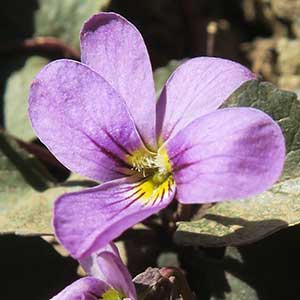Viola flettii
Viola sororia
Flett's violet, Olympic violet, rock violet
common blue violet, common or downy or woolly blue violet, northern blue violet, northern violet, northern woodland violet, violette parente, woolly blue violet
1–3, ascending to erect, mostly glabrous, on caudex from fleshy rhizome.
basal and cauline;
basal: 1–3;
stipules linear-lanceolate, margins entire or with glandular processes, apex acuminate;
petiole 1.5–9.7 cm, mostly glabrous;
blade purple-tinted and –veined, broadly reniform to ovate, 0.9–2.4 × 1.2–4 cm, base cordate, margins finely crenate-serrate, eciliate, apex acute to obtuse, surfaces glabrous or sparsely pubescent along veins adaxially;
cauline similar to basal except: stipules ovate to lanceolate, margins entire or shallowly laciniate;
petiole 0.7–5.9 cm, usually glabrous;
blade 0.8–2.1 × 1.2–3.1 cm.
basal, 1–8, ascending to erect;
stipules linear-lanceolate to broadly lanceolate, margins entire, sometimes glandular distally, apex acute;
petiole 2–25 cm, pubescent or glabrous;
blade green abaxially, unlobed, ovate or broadly ovate to reniform, 2–5 × 2–10 cm, not fleshy, base cordate, margins crenate to serrate, ciliate or eciliate, apex acute to obtuse or rounded, surfaces usually pubescent, rarely glabrous.
1.8–7.1 cm, usually glabrous.
3–25 cm, glabrous or sparsely pubescent.
sepals lanceolate, margins eciliate, auricles 0.5–1.5 mm;
petals soft reddish violet on both surfaces, all with yellow area basally, lower 3 dark violet-veined, lateral 2 bearded, lowest with white around yellow area, 10–15 mm, spur yellow, gibbous, 0.5–2 mm;
style head bearded; cleistogamous flowers axillary.
sepals lanceolate to ovate, margins ciliate or eciliate, auricles 1–2 mm;
petals light to dark blue- or dark purple-violet, reddish purple, or rarely white on both surfaces, usually white basally, lowest and sometimes lateral 2 purple-veined, lateral 2 bearded, lowest bearded or beardless, 15–25 mm, spur same color as petals, gibbous, 2–3 mm;
style head beardless; cleistogamous flowers on prostrate to ascending peduncles.
± spherical, 5–9 mm, glabrous.
ellipsoid, 5–12 mm, glabrous.
dark brown to brownish purple, 2.5–3 mm.
beige, mottled to bronze, 1.5–2.5 mm.
= 54.
Viola flettii
Viola sororia
Viola flettii is endemic to the Olympic Mountains of northwestern Washington. C. S. McCreary (2005) noted that although morphologically and ecologically distinct, V. cuneata, V. flettii, and V. ocellata are closely related.
(Discussion copyrighted by Flora of North America; reprinted with permission.)
Viola sororia is similar to V. palmata in the high degree of phenotypic plasticity. The petal color is usually light to dark blue-violet. In V. sororia forma priceana (the Confederate violet) petals are grayish white with violet veins. Viola septentrionalis was recognized by N. L. Gil-Ad (1997) based on what he considered distinct capsule and seed morphology. His assumptions were based on one to four specimens. A. Haines (2011) alluded to the variability of V. sororia and indicated that a more northern form has often been called V. septentrionalis. He suggested that range-wide patterns of variation make it difficult or impractical to separate. We currently see no valid reason to recognize V. septentrionalis.
Viola floridana was recognized by D. B. Ward (2006) as distinct from V. sororia based on being glabrous except for scattered hairs on petioles.
Viola sororia reportedly hybridizes with V. cucullata (= V. ×bissellii House), V. hirsutula [= V. ×cordifolia (Nuttall) Schweinitz], V. pedatifida var. brittoniana (= V. ×insolita House), V. pedatifida var. pedatifida (= V. ×bernardii Greene), and V. sagittata var. sagittata (= V. ×conjugens Greene).
(Discussion copyrighted by Flora of North America; reprinted with permission.)
- Local floras:
BC,
OR,
WA
- Local Web sites:
Flora NW,
Go Botany,
IL Wildflowers,
KS Wildflowers,
LA Plants,
MD Biodiversity,
MI Flora,
MN Wildflowers,
MO Plants,
PNW Herbaria
WildflowerSearch
iNaturalist (observations)
USDA Plants Database
- LBJ Wildflower Center
- SEINet
- Plants of the World Online
- Encyclopedia of Life
- Wikipedia
- Google Image Search


